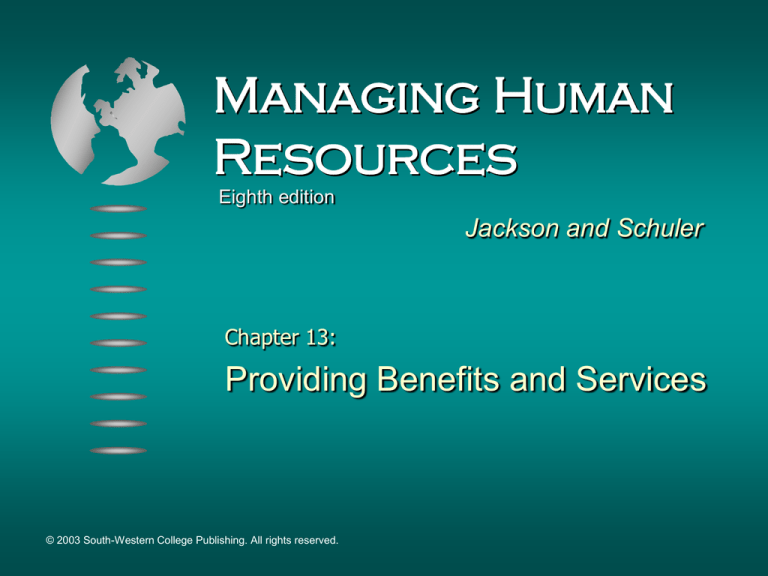
Managing Human
Resources
Eighth edition
Jackson and Schuler
Chapter 13:
Providing Benefits and Services
© 2003 South-Western College Publishing. All rights reserved.
Chapter Outline
Employee Benefits and Services Within an Integrated
HR System
The Strategic Importance of Employee Benefits &
Services
Public Protection Programs
Private Protection Programs
Health Care Benefits & Services
Paid Leave
Work-Life Balance
Other Benefits & Services
Administrative Issues
© 2003 South-Western College Publishing. All rights reserved.
13–2
Terminology
Benefits and Services
In-kind payments to employees
For membership or participation in the organization
Public Protection Programs
Legally required
Social Security, unemployment, workers’
compensation
Private Protection Programs
Voluntary for employers
Health care, life insurance, disability, retirement
© 2003 South-Western College Publishing. All rights reserved.
13–3
Benefits and Services within
an Integrated HR System
Total Compensation
Monetary….Nonmonetary
Other HR
Activities
• Fairness/Legal
• Recruitment
• Compensation
• Safety/Health
Global
Environment
Objectives for
Total
Compensation
• Communicate
Values
• Support Objectives
• Attract, Retain
• Motivate
• Contain Costs
Organizational
Environment
© 2003 South-Western College Publishing. All rights reserved.
Provide Mandatory
Benefits & Services
• Social Security
• Unemployment/Wkrs Comp
Provide Voluntary
Benefits and Services
• Retirement, Medical
• Paid Leave, Life Cycle
Communicate
and Administer
Monitor Health and Safety
13–4
External Influences
Expansion of social security
Social legislation
Competition
Wage controls
Employee
Benefits
Inflation
Health care costs
Union bargaining
Federal tax policies
© 2003 South-Western College Publishing. All rights reserved.
13–5
Internal Influences
Employee wants
Human
resource
philosophy
Employee
Benefits
© 2003 South-Western College Publishing. All rights reserved.
Business
strategy
and
objectives
13–6
Average Annual Monetary Benefits
and Earnings
7%
2%
Pay for Time
Worked
9%
Private Pensions,
Insurance
Paid Vacations
and Rest Periods
14%
Legally Required
Payments
68%
© 2003 South-Western College Publishing. All rights reserved.
Other
13–7
Percentage of Who Rank Each Benefit
Most Important
Stock Options
Disability
Long-term care
Life Insurance
Pension
Retirement Savings
Health Insurance
0
10
© 2003 South-Western College Publishing. All rights reserved.
20
30
40
50
60
70
13–8
The Strategic Importance of
Benefits and Services
Benefits and Services May:
Attract good employees
Increase employee morale
Reduce turnover
Increase job satisfaction
Enhance the organization’s
image
© 2003 South-Western College Publishing. All rights reserved.
13–9
Benefits, Services and Business Strategy
Are generally not considered motivators
Benefits and services are not contingent on
performance
Innovative packages may attract and retain
employees
Communication is important
Many employees don’t know the worth of benefits
they receive
Employees may view benefits as entitlement
Employees differ on the relative value they place
on particular benefit
© 2003 South-Western College Publishing. All rights reserved.
13–10
Business Objectives Addressed by
Benefits and Services
Objective: To unify a company acquired from a
merger
Benefits Response: Analyze immediate versus
gradual transfer of subsidiary employees into
corporate benefits plan.
Objective: To cut accident rates 10% by year
end
Benefits Response: Establish employee assistance
program. Set up literacy training to ensure
employees can read safety signs.
© 2003 South-Western College Publishing. All rights reserved.
13–11
Benefits Costs
In 1929, total benefits
averaged 5% of total
pay, in 2000: 30% of
Wages and salaries are
40 times greater than 60
years ago
Benefits and services
are 500 times greater
© 2003 South-Western College Publishing. All rights reserved.
13–12
Public Protection Programs
Social security system
Unemployment
© 2003 South-Western College Publishing. All rights reserved.
compensation benefits
Workers’ compensation
and disability
13–13
Social Security
Social Security Act of 1935; Medicare was
added in 1966
Federal Insurance Contributions Act (FICA)
6.2% of the first $68,400 income for retirement
and disability
1.45% of total income for hospital insurance
(Medicare)
Equal contributions from the employer and the
employee
© 2003 South-Western College Publishing. All rights reserved.
13–14
Unemployment Compensation
Jointly administered by Federal and State
governments
Tax rates for employers vary based on
number of people using benefits
Level of benefits ranges
50-70% of base salary
© 2003 South-Western College Publishing. All rights reserved.
13–15
Workers’ Compensation
Covers costs and lost income due to injury or
illness that result from on-the-job events
Administered by states
Fully financed by employers
Managing workers’ compensation costs:
Use health care cost-containment strategies (audit
bills, develop preferred providers, etc.)
Implement job safety programs
Combine with disability management
© 2003 South-Western College Publishing. All rights reserved.
13–16
Relevant Laws
Pregnancy Discrimination Act of 1978
Pregnancy is defined as a disability.
Female employees (and spouses)
must receive same benefits for
pregnancy as for other disabilities.
© 2003 South-Western College Publishing. All rights reserved.
13–17
Family and Medical Leave Act of 1993
Covers employers with 50 or more workers
Required to grant up to 12 weeks of unpaid
leave annually
For birth/adoption
To care for immediate family member with serious
health condition
For employee with serious health condition
Employee keeps preexisting health coverage
and must be allowed to return to same or
equivalent job
© 2003 South-Western College Publishing. All rights reserved.
13–18
Relevant Laws (cont’d)
Economic Recovery Tax Act of 1981
Employees allowed to make tax deductible
contributions to employer-sponsored plan or
individual retirement account (IRA)
Encouraged employee stock ownership
Health Insurance Portability and
Accountability Act of 1996
Facilitates employees’ transfer of
coverage when they change jobs
© 2003 South-Western College Publishing. All rights reserved.
13–19
Economic Growth and Tax Relief
Reconciliation Act of 2001
Raises contribution limits for IRAs and employersponsored retirement plans
Reduces (to 3 yrs) length of service before employer
contributions to retirement programs must be
available
Shortens pension vesting waiting periods
Eliminates federal taxes on
withdrawals from college
savings plans
© 2003 South-Western College Publishing. All rights reserved.
13–20
Private Protection Programs
Are not required by law
Include
Retirement income plans
Capital accumulation plans
Savings and thrift plans
Supplemental unemployment
Guaranteed pay
© 2003 South-Western College Publishing. All rights reserved.
13–21
Pension Plans
Qualified Plan:
Covers broad class of employees
Receives favorable tax treatment
ERISA (Employee Retirement Income
Security Act of 1974)
Protects benefits for workers covered by private
pension plans; prohibits unfunded plans
Specifies provisions for vesting (time when
employer’s contribution belongs to employee)
© 2003 South-Western College Publishing. All rights reserved.
13–22
Types of Pension Plans
Defined Benefit Plan
Benefits vary with age and length of service
Provides predictable income after retirement
Penalizes employee mobility
Regulated by ERISA
Cash Balance Plan
Pays a lump sum upon employees’
departure
Has become more popular as
employee mobility has increased
© 2003 South-Western College Publishing. All rights reserved.
13–23
Types of Pension Plans (cont’d)
Defined Contribution Plans
Each employee has separate account
Employer may contribute (contributory) or not
(noncontributory)
Money purchase plans
• Employer makes regular contributions
Tax-deferred profit-sharing plans
• Employees share profits and
investment risk
© 2003 South-Western College Publishing. All rights reserved.
13–24
Supplemental Plans
401K Plans
Employer and employee contribute to fund
Employee makes investment decisions
Employee stock and stock option plans
Recent trend is to offer to all employees
© 2003 South-Western College Publishing. All rights reserved.
13–25
Health Care Benefits and Services
Medical Coverage
Wellness Programs
Employee Assistance Programs
Disability Insurance
© 2003 South-Western College Publishing. All rights reserved.
13–26
Medical Care
Most employees underestimate cost and view
medical care as an entitlement
Companies that provide health insurance
spend more than 13 cents of every dollar they
make to pay for coverage.
© 2003 South-Western College Publishing. All rights reserved.
13–27
Medical Care Approaches
Insurance Companies
Provider Organizations
Health Maintenance Organizations (HMOs)
Preferred Provider Networks
Self-Funded Plans
© 2003 South-Western College Publishing. All rights reserved.
13–28
Medical Cost Containment Strategies
Hospital utilization
© 2003 South-Western College Publishing. All rights reserved.
programs
Coordination of benefits
Data analysis
Case management
Cost sharing with
employees
Incentives to promote
employee health
13–29
Wellness Programs
Proactive programs to prevent health
problems
May include:
On-site exercise programs
Stress-management training
Assistance to stop smoking
Weight-loss programs
© 2003 South-Western College Publishing. All rights reserved.
13–30
Employee Assistance Programs
Assist employees with chronic personal
problems that hinder job performance and
attendance
Employees referred to confidential counseling
services
Includes help with alcohol and drug
dependencies, domestic problems, mental
disorders, financial problems
© 2003 South-Western College Publishing. All rights reserved.
13–31
Paid Leave
Off the job:
Vacations and holidays
Paid absences
On the job
Lunches, rest periods
© 2003 South-Western College Publishing. All rights reserved.
13–32
Managing Absenteeism
In U.S., average daily absenteeism rate 2-3%
of payroll.
Programs that reward attendance may be
more effective than disciplinary approaches.
Personal Time Off (PTO) benefits may prevent
unscheduled absenteeism.
© 2003 South-Western College Publishing. All rights reserved.
13–33
Work-Life Balance
Child Care Services
Dependent care reimbursement accounts
Resource and referral programs
On-site care facilities
Flexible scheduling
Backlash from child-free
workers tends to be
limited in scope
© 2003 South-Western College Publishing. All rights reserved.
13–34
Work-Life Balance
Elder Care Services
Information and referral programs
Long-term care insurance
28% of employees over 30
spend an average of 10
hours a week giving care
to an older relative
© 2003 South-Western College Publishing. All rights reserved.
13–35
Work-Life Balance (cont’d)
Other Life Cycle and Life Style Benefits
Benefits for spousal equivalents
Educational expense allowances
Relocation and housing assistance
© 2003 South-Western College Publishing. All rights reserved.
13–36
Administrative Issues
Determining
the benefits
package
Communicating
the benefits
package
© 2003 South-Western College Publishing. All rights reserved.
Providing
benefits
flexibility
Managing
& reducing
benefits
costs
13–37
Determining the Benefits and
Services Package
Employee preferences vary considerably and
are difficult to predict, based on demographic
characteristics.
Corporate size, ability to pay, strategy and
culture affect benefits decisions.
Flexible plans, which allow employee choice
of benefits, are very effective.
© 2003 South-Western College Publishing. All rights reserved.
13–38
Communicating the Benefits and
Services Package
Most companies use
passive, impersonal
techniques
New approaches
include:
Voice response
systems (call
centers)
Intranet web sites
© 2003 South-Western College Publishing. All rights reserved.
13–39




